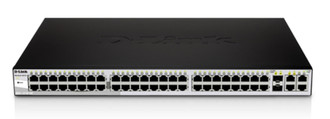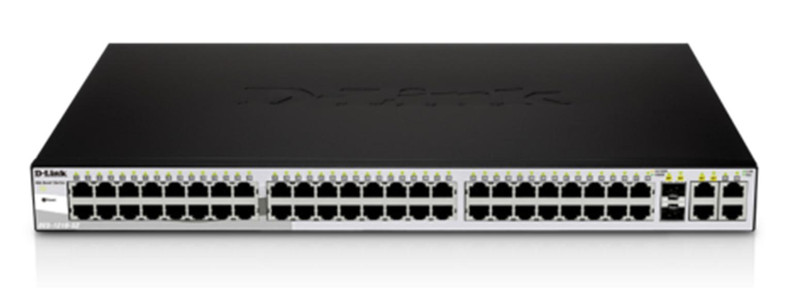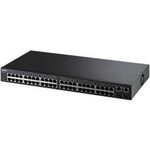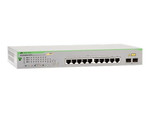目錄的
-
目錄的
- Antiquitäten & Kunst
- Auto & Motorrad: Fahrzeuge
- Baby
- Bücher
- Camping & Outdoor
- Feinschmecker
- Haustierbedarf
- Heimwerken & Garten
- IT和电子
- Kleidung & Accessoires
- Modellbau
- Musik
- PC- & Videospiele
- Sammeln & Seltenes
- Spielzeug
- TV, Video, DVD
- Telekommunikation
- Uhren & Schmuck
- Wellness & Beauty
- fashion & lifestyle
- institutional food services equipment
- medical equipment, accessories & supplies
- 个人护理
- 休闲爱好
- 办公设备,用品和配件
- 商业与工业
- 家居,建筑,装修
- 家用电器
- 摩托车及配件
- 武器和弹药
- 照相机
- 花园和庭院
- 运动,娱乐及休闲
- 食物
- 高保真音響
Filters
Search
D-Link DES-1210-52 Managed L2 1U Black network switch
凡购买和价格 (Advertising *)
顶部
技术特点
顶部
管理功能
| 支持多重播放 | Y |
|---|---|
| 支持管理信息基本原则 | MIB II, Bridge MIB, SNMPv2 MIB, MIB Traps Convention, Interface Group MIB, Private MIB |
| 交换层 | L2 |
| 支持服务质量(QoS) | Y |
| 网上管理 | Y |
数据传输
| MAC 地址表 | 8000 entries |
|---|---|
| 存储转发 | Y |
| 支持数据传输率 | 10/100/1000 Mbps |
| 交换容量 | 17.6 Gbit/s |
| 最大数据传输率 | 1 Gbit/s |
| VLAN 数量 | 256 |
环境条件
| 散热 | 98.61 BTU/h |
|---|---|
| 运行湿度范围(H-H) | 10 - 95% |
| 储存温度范围 (T-T) | -10 - 70 °C |
| 储存相对湿度范围(H - H) | 5 - 95% |
其他功能
| 绩效管理 | Telnet, Telnet Server, TFTP Client, SNMP v1/v2/v3, SNMP Trap |
|---|---|
| 数据包包传输速度 | 3.1 Mpps |
| 连通的液晶显示器 | Y |
| 电磁辐射 | FCC Class A, CE Class A, VCCI Class A, C-Tick |
| 接受频率 | 50/60 Hz |
联网
| 端口镜像 | Y |
|---|---|
| 广播风暴控制 | Y |
| IGMP侦听 | Y |
| 自动 MDI / MDI - X 检测功能 | Y |
| 链路汇集 | Y |
| 生成树协议 | Y |
| 网络标准 | IEEE 802.3, IEEE 802.3ab, IEEE 802.3u, IEEE 802.3x, IEEE 802.3z |
| 流量控制支持 | Y |
| 动态主机配置协议客户 | Y |
| 10G支持 | N |
| 全双工传输 | Y |
端口 & 界面
| SFP/SFP+端口数量 | 2 |
|---|---|
| 基本交换 RJ-45 以太网端口数量 | 48 |
| SFP模块插槽数量 | 2 |
| 以太网铜缆技术 | 100BASE-TX, 1000BASE-T, 10BASE-T |
| 千兆以太网(铜)端口数量 | 2 |
能量控制
| 输入电压 | 100 - 240 V |
|---|---|
| 功耗(一般操作) | 28.9 W |
性能
| 程序包缓冲区内存 | 1 MB |
|---|---|
| 平均故障间隔时间 | 289012 h |
| 可堆叠 | N |
设计
| 安全 | cUL, LVD |
|---|---|
| 格式要素 | 1U |
| 机架安装 | Y |
重量和尺寸
| 深度 | 250 mm |
|---|---|
| 重量 | 3300 g |
| 宽度 | 441 mm |
| 高度 | 44 mm |
安全
| 存取控制清单(ACL) | Y |
|---|
以太网电源(PoE)
| 支持以太网(PoE) | N |
|---|
另外
| 产品色彩 | Black |
|---|---|
| 运行温度范围(T - T) | 0 - 40 °C |
| 连接方式 | Wired |
24/48-Port Web Smart Switch III
D-Link’s DES-1210 Series is the latest generation of Web Smart Switches. Equipped with 24 or 48
10/100Mbps ports, 2 10/100/1000BASE-T ports, and 2 combo 10/100/1000BASE-T/SFP ports, the series integrates advanced management and security functions that provide performance and scalability. While easy to use, the DES-1210 Series provides a complete and affordable solution for small and medium businesses. Management options for the switches include SNMP, Web Management, SmartConsole Utility, and Compact Command Lines. The series also supports ACL filtering and D-Link’s Safeguard Engine. Furthermore, the DES-1210-28/52 uses Auto Voice VLAN, ensuring higher priority for voice traffic. Both models come with an innovative fanless design in 19”
metal cases.
Seamless Integration
The Web Smart Switches are designed to provide SMB users a complete control over the network.
With Ethernet and Gigabit copper ports capable of connecting to existing Cat.5 twisted-pair cables,
these switches eliminate the need for a complex reconfiguration process. The DES-1210 Series allows
for flexible connection to a backbone or servers. Additionally, all ports support auto-negotiation of
MDI/MDIX crossover, or configurable auto MDI and therefore do away with crossover cables or uplink
ports. This brings inexpensive and easy connectivity to your desktop.
Extensive Layer 2 Features
Equipped with a complete lineup of L2 features, these switches include IGMP Snooping, Port Mirroring,
Spanning Tree and Link Aggregation Control Protocol (LACP). The IEEE 802.3x Flow Control function allows servers to directly connect to the switch for fast, reliable data transfer. At 2000Mbps Full Duplex, the Gigabit ports provide high-speed data pipes to servers with minimum data transfer loss. Network maintenance features include Loopback Detection and Cable Diagnostics. Loopback Detection is used to detect loops created by a specific port and automatically shut down the affected port. Cable
Diagnostics is designed for network administrators to quickly examine the quality of the copper cables and also determine the type of cable error.
QoS, Bandwidth Control
The switches are perfect for deployment in a VoIP environment, as they support Auto Voice VLAN and
Differentiated Services Code Point (DSCP) QoS for VoIP application. Auto Voice VLAN will automatically
place voice traffic from an IP phone to an assigned VLAN and by doing so enhance the VoIP service. With a higher priority and individual VLAN, this feature guarantees the quality and security of VoIP traffic. DSCP marks parts of an IP packet, enabling different levels of service to be assigned for network traffic. With Bandwidth Control, the network administrator can reserve bandwidth for important functions that require a larger bandwidth or might have high priority.
Secure your Network
D-Link’s innovative Safeguard Engine function protects the switches against traffic flooding caused
by virus attacks. The switches support 802.1X portbased authentication, allowing the network to be
authenticated through external RADIUS servers. In addition, the Access Control List (ACL) feature
enhances network security and helps to protect the internal IT network. With the IP-MAC-Port Binding
(DHCP Snooping) feature, the switch snoops DHCP information in order to automatically learn IP-MACPort Binding pairs and create a white list. Whenever cyber crime or hacking attempts are found, the IP change is kept under control and the location of the IP address becomes traceable. For added security, the DHCP Server Screening feature screens rogue DHCP server packets from user ports to prevent unauthorized IP assignment.
Versatile Management
The new generation of Web Smart Switches provides growing businesses simple and easy management of their network using an intuitive SmartConsole utility or a web-based management interface that enables administrators to remotely control their network down to the port level. The SmartConsole easily allows customers to discover multiple D-Link Web Smart Switches within the same L2 network segment. With this utility, users do not need to change the IP address of their PC and it also provides an easy initial setting of the Smart Switches. Switches within the same L2 network segment that are connected to the user’s local PC are displayed on screen for instant access.
This allows extensive switch configuration settings and basic configuration of discovered devices such
as password changes and firmware upgrades. The DES-1210 Series also supports D-View 6.0 and
Compact Command Line Interface (CLI) through Telnet. D-View 6.0 is a Network Management
System that allows for the central management of critical network characteristics such as availability,
reliability, resilience, and security in a consistent way. D-View 6.0 provides a useful set of tools for network administrators who want to effectively manage device configurations, fault tolerance, performance, and security. CLI management of the switches is possible via Telnet. This makes the adjustment of basic settings like password changes or firmware and configuration file uploads possible.
D-Link’s DES-1210 Series is the latest generation of Web Smart Switches. Equipped with 24 or 48
10/100Mbps ports, 2 10/100/1000BASE-T ports, and 2 combo 10/100/1000BASE-T/SFP ports, the series integrates advanced management and security functions that provide performance and scalability. While easy to use, the DES-1210 Series provides a complete and affordable solution for small and medium businesses. Management options for the switches include SNMP, Web Management, SmartConsole Utility, and Compact Command Lines. The series also supports ACL filtering and D-Link’s Safeguard Engine. Furthermore, the DES-1210-28/52 uses Auto Voice VLAN, ensuring higher priority for voice traffic. Both models come with an innovative fanless design in 19”
metal cases.
Seamless Integration
The Web Smart Switches are designed to provide SMB users a complete control over the network.
With Ethernet and Gigabit copper ports capable of connecting to existing Cat.5 twisted-pair cables,
these switches eliminate the need for a complex reconfiguration process. The DES-1210 Series allows
for flexible connection to a backbone or servers. Additionally, all ports support auto-negotiation of
MDI/MDIX crossover, or configurable auto MDI and therefore do away with crossover cables or uplink
ports. This brings inexpensive and easy connectivity to your desktop.
Extensive Layer 2 Features
Equipped with a complete lineup of L2 features, these switches include IGMP Snooping, Port Mirroring,
Spanning Tree and Link Aggregation Control Protocol (LACP). The IEEE 802.3x Flow Control function allows servers to directly connect to the switch for fast, reliable data transfer. At 2000Mbps Full Duplex, the Gigabit ports provide high-speed data pipes to servers with minimum data transfer loss. Network maintenance features include Loopback Detection and Cable Diagnostics. Loopback Detection is used to detect loops created by a specific port and automatically shut down the affected port. Cable
Diagnostics is designed for network administrators to quickly examine the quality of the copper cables and also determine the type of cable error.
QoS, Bandwidth Control
The switches are perfect for deployment in a VoIP environment, as they support Auto Voice VLAN and
Differentiated Services Code Point (DSCP) QoS for VoIP application. Auto Voice VLAN will automatically
place voice traffic from an IP phone to an assigned VLAN and by doing so enhance the VoIP service. With a higher priority and individual VLAN, this feature guarantees the quality and security of VoIP traffic. DSCP marks parts of an IP packet, enabling different levels of service to be assigned for network traffic. With Bandwidth Control, the network administrator can reserve bandwidth for important functions that require a larger bandwidth or might have high priority.
Secure your Network
D-Link’s innovative Safeguard Engine function protects the switches against traffic flooding caused
by virus attacks. The switches support 802.1X portbased authentication, allowing the network to be
authenticated through external RADIUS servers. In addition, the Access Control List (ACL) feature
enhances network security and helps to protect the internal IT network. With the IP-MAC-Port Binding
(DHCP Snooping) feature, the switch snoops DHCP information in order to automatically learn IP-MACPort Binding pairs and create a white list. Whenever cyber crime or hacking attempts are found, the IP change is kept under control and the location of the IP address becomes traceable. For added security, the DHCP Server Screening feature screens rogue DHCP server packets from user ports to prevent unauthorized IP assignment.
Versatile Management
The new generation of Web Smart Switches provides growing businesses simple and easy management of their network using an intuitive SmartConsole utility or a web-based management interface that enables administrators to remotely control their network down to the port level. The SmartConsole easily allows customers to discover multiple D-Link Web Smart Switches within the same L2 network segment. With this utility, users do not need to change the IP address of their PC and it also provides an easy initial setting of the Smart Switches. Switches within the same L2 network segment that are connected to the user’s local PC are displayed on screen for instant access.
This allows extensive switch configuration settings and basic configuration of discovered devices such
as password changes and firmware upgrades. The DES-1210 Series also supports D-View 6.0 and
Compact Command Line Interface (CLI) through Telnet. D-View 6.0 is a Network Management
System that allows for the central management of critical network characteristics such as availability,
reliability, resilience, and security in a consistent way. D-View 6.0 provides a useful set of tools for network administrators who want to effectively manage device configurations, fault tolerance, performance, and security. CLI management of the switches is possible via Telnet. This makes the adjustment of basic settings like password changes or firmware and configuration file uploads possible.
類似的優惠
顶部
-
支付方式
我们接受:



















